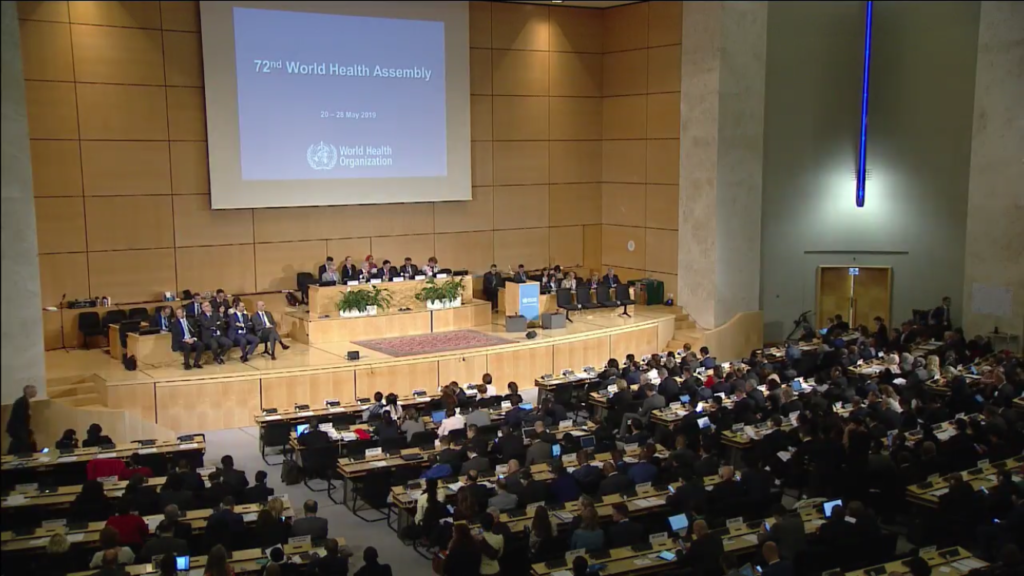In this blog post, our Vice President of Global Strategy and Advocacy Bistra Zheleva shares her impressions about the 72nd World Health Assembly. This is a decision-making forum through which the World Health Organization is governed by its 194 member states. Its resolutions influence health care across the world, including care for children with heart disease.

Last week I attended the 72nd World Health Assembly. Only I wasn’t in Geneva where this meeting takes place but instead attended virtually by following the discussions on social media and watching all events that were live streamed. I would say it was a very efficient and still effective way to “participate,” minus the opportunity to personally interact with colleagues and policymakers — and some interference with my sleep patterns over the week, plus of proceedings and side events.
You are probably wondering why Children’s HeartLink would be interested in the World Health Assembly. Highlighted throughout were two primary topics: a healthy planet and climate change, and gender inequities in health care. Other urgent health issues were also discussed, including the Ebola epidemic and the risk of its spread, health security, humanitarian assistance, and the health of migrants and refugees. This forum’s resolutions also impact children living with heart disease.
When Children’s HeartLink published The Invisible Child, the series that initiated discussion about including pediatric cardiac care in the global health agenda, we included a call to action that spelled out:
- increasing health system capacity to care for children with heart disease
- building a pediatric cardiac workforce
- closing the data gap about the prevalence of congenital heart disease
- financing of pediatric cardiac care
Decisions made this week during the World Health Assembly can impact all of these issues.
At the outset, it was encouraging to see that the World Health Organization progress report on the Implementation of the 2030 Agenda for Sustainable Development to member countries included two references to the burden of congenital anomalies. They are an important cause of death among newborns and young children, and congenital heart disease is the most common type of birth defect.
The most negotiated resolution was the one on improving the transparency of markets for medicines, vaccines and other health products. This can be important to patients with heart disease because they rely on many specialized medicines and supplies.
There was also a resolution on improving water safety, sanitation and hygiene services in health facilities, to prevent the spread of infections, a critical component of safe pediatric cardiac care, especially after surgery. This is still an issue even in middle-income countries. Sadly, central water supply contamination was recently experienced at one of our partner hospitals.
Universal health coverage
Most discussions fit under the banner of universal health coverage, ahead of the United Nations high-level meeting on the same topic in New York during the September UN General Assembly. Universal health coverage implying that all the people have access to healthcare is particularly relevant to children with heart disease and their families because of its all-encompassing nature, with focus on integrated care and financing that would prevent catastrophic health expenditures for families. Many speakers cited both the difficulty and the need for political will to make it a reality.
“Universal health coverage is a nation-building process with passion, commitment, love and trust.” I loved the clarity of this description from Takao Toda, Vice President of the Japan International Cooperation Agency, while he was talking about Japan’s experience of implementing universal insurance coverage in the early 1960s and the country’s health improvements since then.
Along the same lines, it was wonderful to see the commitment of the Malaysian government in promoting universal health coverage. Children’s HeartLink partners with the government of Malaysia to expand its capacity for pediatric cardiac services. Universal healthcare system will drive the growth of pediatric cardiac services in the country and help many more children in the future.
Other discussions
Worth noting were the discussions and side events on global surgery, with calls for countries to start developing their National Surgical Obstetrics and Anesthesia Plans. These plans provide a platform to elevate efforts and resources to ensure optimum quality, safety, affordability, and access to surgical and anesthesia care. I hope they will incorporate heart surgery for children in these plans.
There were discussions about including noncommunicable diseases, which include pediatric heart disease, in universal health coverage. Especially exciting was the continued widening participation of youth advocates for noncommunicable diseases.
The members of the World Health Assembly also discussed health workforce development, highlighting the gap of 18 million health workers globally. Development of the pediatric cardiac workforce is a strategic priority for Children’s HeartLink.
Finally, it was exciting to see the country member states establishing an annual World Patient Safety Day on September 17 and a World Chagas Disease Day on April 14 (to add a global voice to “neglected diseases”). They also declared 2020 the Year of the Nurse and the Midwife.
